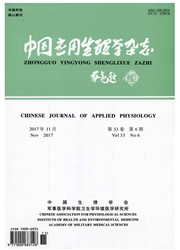

 中文摘要:
中文摘要:
目的:观察缺失触液核(CSF-contacting nucleus)对大鼠痛行为及脊髓背角痛相关物质5-羟色胺(5-HT)和c—Fas表达的影响,为触液核参与疼痛调制及机制提供实验依据。方法:成年雄性SD大鼠随机分为正常组(Control),假手术组(Sham),霍乱毒素亚单位B与辣根过氧化酶复合物(CB—HRP)组和毁损触液核组(Damage)。以机械缩足阈值(MWT)和热缩足潜伏期(耶儿)测定大鼠痛行为。免疫荧光法检测脊髓背角5-HT和c—Fos表达,并进行痛行为阈值与物质变化趋势的相关分析。结果:与Control、Sham和CB—HRP组相比,Damage组大鼠MWT和TWL明显降低(P〈0.05)。免疫荧光结果显示,正常大鼠触液核神经元高表达5-HT;Damage组大鼠触液核神经元数量随毁损天数延续逐渐减少,且在给予毁损剂CB—SAP第10天完全消失。与此同时脊髓背角5-HT和c—Fos表达量日趋增加,且与痛行为阈值变化趋势成负相关。结论:CB—SAP能科学可靠靶向毁损触液核,缺失触液核可致大鼠痛行为阈值减低,而脊髓背角5-HT和c—Fos表达量增加。本研究提示触液核参与了疼痛调制,且5-HT和c—Fos在此调制中发挥了重要作用。
 英文摘要:
英文摘要:
Objective: The changes of pain threshold and expression of 5-hydroxytryptamine(5-HT) and c-Fos in spinal dorsal horn of rats were observed after targetedly damaged the cerebraspinal fluid-contacting nucleus( CSF-coutacting nucleus) to provide experimental evidence for the mechanism of regulating pain CSF-contacting nucleus involved in. Methods: Male adult SD rats were divided into control, sham, choleratoxin subunit B conjugated with horse-radish peroxidase(CB-HRP) and damage groups randomly. The pain threshold using mechanical withdrawal threshold (MWT) and thermal withdrawal latency (TWE) were recorded and analyzed the expression of 5-HT and c-Fos in spinal dorsal horn. Results: Compared with the control, sham and CB-HRP groups, the MWT and TWL of the damage group were significantly increased ( P 〈 0.05). The results of immunofluorescence showed that 5-HT was detected in neurons of CSF-contacting nucleus. In the damage group, the number of neurons of CSF-contacting nucleus reduced gradually, and no survived neurons were observed at the 10th day. Meanwhile, both the expression of 5-HT and c-Fos in spinal dorsal horn increased gradually, and negatively correlated with the change of pain threshold. Conclusion: The method of targeted damaging CSF-contacting nucleus by cholera toxin subnit B conjugated with saporin(CB-SAP) is scientific and reliable, and it results in the changes of pain threshold and expression of 5-HT and c-Fos in spinal dorsal horn of rats. This study suggests that CSF-contacting nucleus participate in the regulation of pain, moreover, 5-HT and c-Fos play important roles in this regulation.
 同期刊论文项目
同期刊论文项目
 同项目期刊论文
同项目期刊论文
 期刊信息
期刊信息
